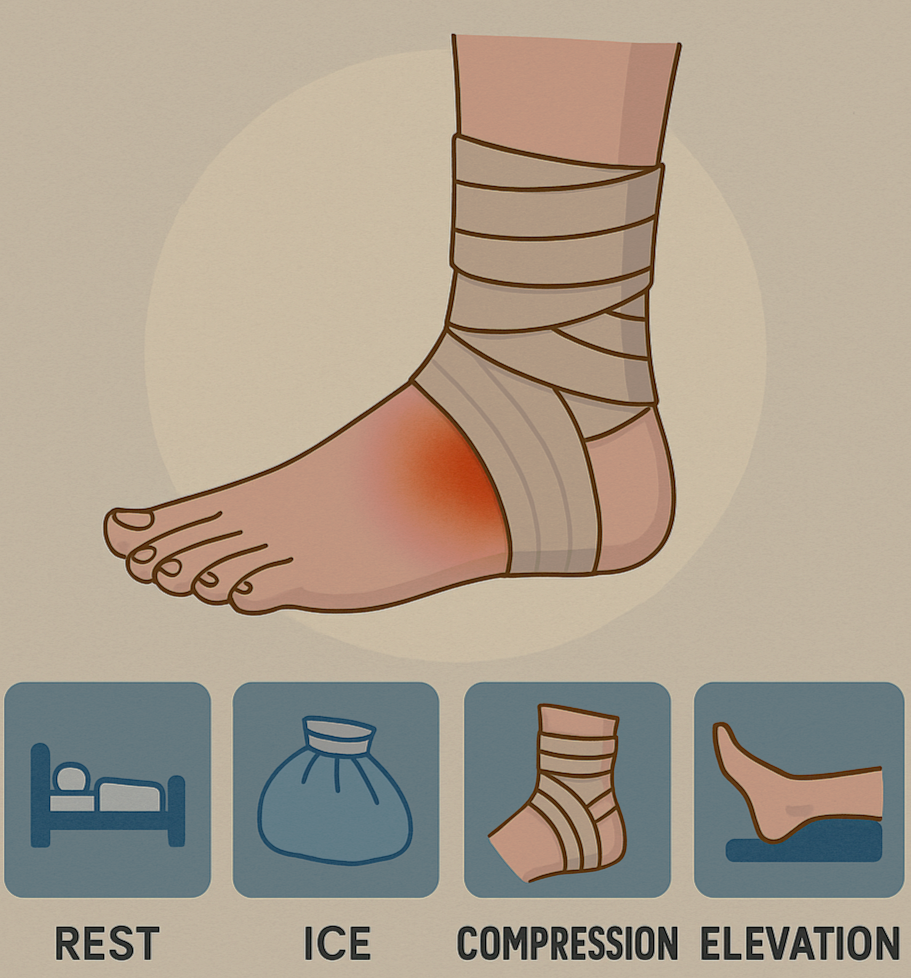Ankle Sprain Rehab: More than R.I.C.E.
Hey, I’m Dr. Grant with Delphi Orthopedic Wellness. If you’ve rolled your ankle recently and feel like it’s “mostly” better — but something’s still not right — this is for you.
You might be walking just fine. Maybe the swelling is down and you’re back to your normal daily stuff. But when it comes to the things you actually love doing — like running, pickleball, hiking, lifting — your ankle is holding you back. It might feel stiff, weak, or just… off. Like you don’t trust it anymore.
I see this all the time, and there are two big reasons people get stuck here:
Mobility deficits
Proprioception problems
Let’s break both down and then give you a few simple tools to start rebuilding confidence and control in that ankle. Because at Delphi, we don’t dabble in short-term pain relief — we’re here to guide you toward lasting recovery.
Before we dive in here, let’s make sure we are on the same page with a little background you probably already know about — because you know how to use the internet.
BASICS
The most common ankle sprain is the lateral ankle sprain — when you take a bad step, your foot turns in, and you end up with swelling and soreness on the outside/front of the ankle. In more severe cases (grade 2 or 3), swelling will be accompanied by bruising and more intense pain.
The first answer might sound familiar because it’s what your mom would tell you to do:
Simple and effective.
You wont hear me ever tell you to stop running, hiking or lifting as a long term solution. Life is risky, exercise is risky, most fun things have an element of risk. What kind of boring uneventful life you would have if you always avoided the chance of failure or injury…
…Okay ill step off my soap box.
I say this to make sure no one interprets my recommendation of rest as my forever advise.
That being said, this will be the right choice for the first few days, and then in the evening for the first 1–2 weeks. But rest does not mean do nothing. You should engage in ankle mobility drills and light stretching — guided by pain and common sense.
**I am a Doctor of Physical Therapy, so I need to mention this is not personalized medical advice. This is for smart, independent people who know how to listen to their body.
Anyways, that’s the basics — now let’s dive into the meat and potatoes.
MOBILITY
After the swelling subsides, scar tissue can form and limit the joint capsule — leading to reduced ankle movement. That might sound worse than it is. All it really means is: the bones of your ankle need to move better again.
This is especially important for dorsiflexion — lifting the toes toward the shin.
Banded Ankle Mobilization
This drill can help restore movement and clear out leftover joint fluid:
Grab a resistance band and anchor it low behind you.
Step into the band with your affected foot so it pulls backward around the ankle joint (just below the bony bumps on either side of your ankle).
In a lunge position, drive your knee forward over your toes while keeping your heel down.
Perform 2–3 sets of 15–20 reps.
PROPRIOCEPTION: Your Brain & Ankle Are Out of Sync
Proprioception is your body’s ability to sense where it is in space. It’s how you can stand on one foot, cut side-to-side, or adjust mid-stride without thinking.
When you sprain your ankle, it’s not just the ligament that gets stretched — the communication between your ankle and brain gets disrupted. That automatic feedback loop? It’s scrambled. And if you’ve been babying that ankle, the connection got even weaker.
That’s why your ankle might feel fine walking slowly… but unstable when you try to move fast, turn sharply, or land from a jump.
Don’t let that steal your confidence — these drills will help get you back on track:
Proprioception Drills
Heel Walks & Toe Walks: 30 seconds each, 2–3 rounds
Ball Against the Wall (Eversion Taps): Lightly press a soccer ball outward into the wall and release
Single Leg Balance Progression
Eyes open, firm surface
Eyes closed
Stand on a pillow or foam pad
These challenge your ankle without relying on vision or rigid support — which forces your proprioception to re-engage.
ACTIVITY-SPECIFIC OVERLOAD
Want to get back to running?
Start with slow intervals:
Walk for 30 seconds
Jog lightly for 30 seconds
Repeat for 10–15 minutes
Progress your speed and duration gradually. Don’t let your ego blow all your hard work. If you push too fast, too soon, you risk re-spraining that ankle — and that means back to day one. Not ideal.
Return to pickleball:
HOW LONG SHOULD THIS TAKE?
Give these drills a solid 10–14 days of consistent effort. You don’t need an hour a day — just 10–15 focused minutes.
If you’re improving, keep going. But if you’re still not trusting that ankle after two weeks? That’s your cue to level up your care.
WHY THIS MATTERS AT DELPHI
At Delphi Orthopedic Wellness, we believe in long-term solutions — not Band-Aid fixes. We don’t throw generic plans at you. We listen, assess, and build a tailored recovery path.
You deserve more than “just rest it” or “take Advil” advice. You deserve expert care that helps you:
Get back to weekend hikes in Boerne
Win on the pickleball court
Move with strength and confidence again
READY TO FIX IT FOR GOOD?
Don’t just take my word for it. Book a free 15-minute consultation with me, Dr. Grant, and let’s talk about your ankle, your goals, and whether we’re the right fit to get you back out there.
If I don’t deliver world-class care, I promise I’ll make it right.
Now get after it!
— Dr. Grant, Physical Therapist Extraordinaire



